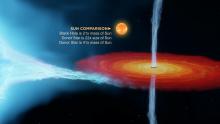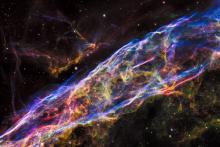Listen to today's episode of StarDate on the web the same day it airs in high-quality streaming audio without any extra ads or announcements. Choose a $8 one-month pass, or listen every day for a year for just $30.
You are here
Dark Passage
TOI-5205b didn’t make astronomers work that hard to find it. But they did spend months learning the planet’s details, and they’re planning to learn even more.
Most of the more than 5,000 confirmed planets in other star systems were found when they passed across the face of their parent star, blocking some of its light. Often, that dip is so small that it can take a while to confirm that it’s real.
That wasn’t the case with TOI-5205b, which was discovered by a space telescope. The planet blocks seven percent of the star’s light — a huge fraction.
Astronomers followed up with several ground-based telescopes, including the Hobby-Eberly Telescope at McDonald Observatory.
The observations revealed that the planet is a little bigger and heavier than Jupiter, the giant of our own solar system. It’s huge compared to the star, which is about 40 percent the size and mass of the Sun, and it’s quite close in. The combination makes it unique among the exoplanets discovered so far.
Starlight filters through the planet’s atmosphere. Studying that light should reveal how and where the planet was born, how it’s moved, and more — details about a planet that doesn’t try to hide.
The TOI-5205 system is about 300 light-years away. It’s to the right of bright Cygnus, the swan, in the wee hours of the morning. But you need a telescope to see the star — even outside the dark passages of its giant planet.
Script by Damond Benningfield






